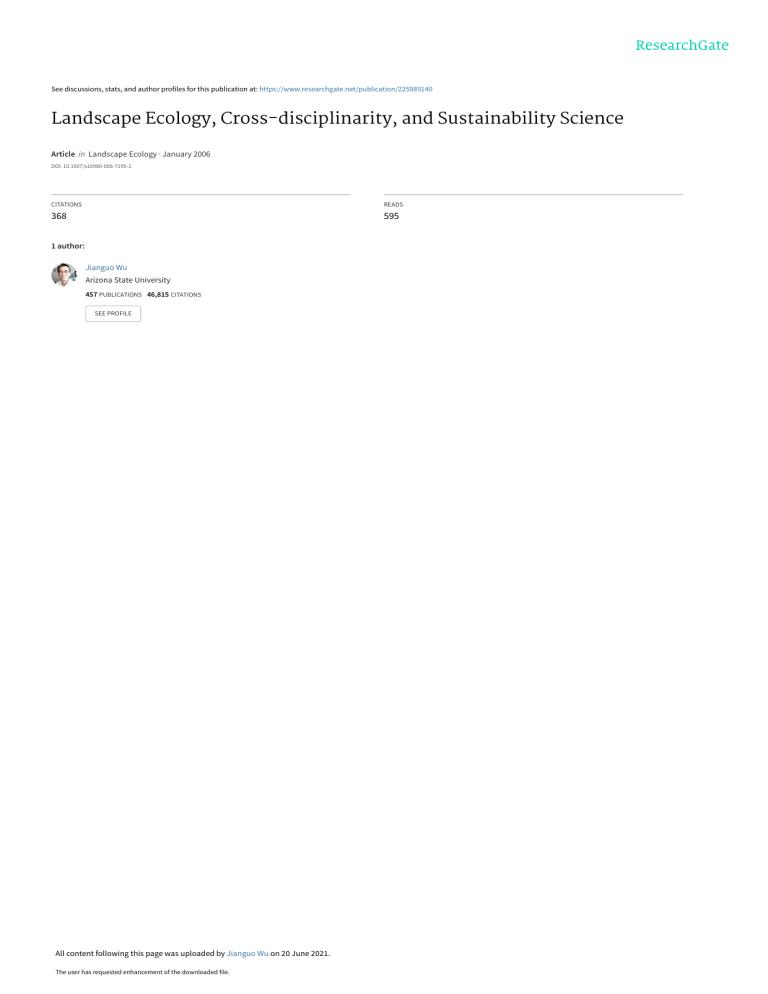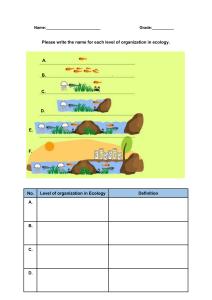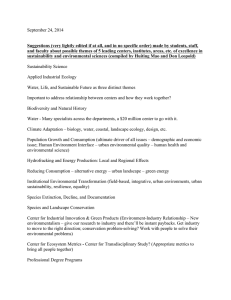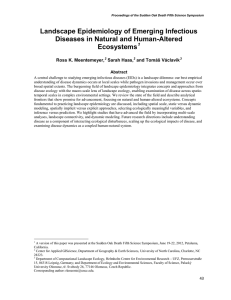
See discussions, stats, and author profiles for this publication at: https://www.researchgate.net/publication/225989140 Landscape Ecology, Cross-disciplinarity, and Sustainability Science Article in Landscape Ecology · January 2006 DOI: 10.1007/s10980-006-7195-2 CITATIONS READS 368 595 1 author: Jianguo Wu Arizona State University 457 PUBLICATIONS 46,815 CITATIONS SEE PROFILE All content following this page was uploaded by Jianguo Wu on 20 June 2021. The user has requested enhancement of the downloaded file. Springer 2006 Landscape Ecology (2006) 21:1–4 DOI 10.1007/s10980-006-7195-2 -1 Editorial Landscape ecology, cross-disciplinarity, and sustainability science Landscape ecology has been widely recognized as a highly interdisciplinary science of heterogeneity. In general, heterogeneity refers to a multiscaled structure composed of intertwining patchiness and gradients in space and time. It is the revelation of the importance of heterogeneity that makes the landscape perspective so pervasively relevant to ecology at different organizational levels as well as earth sciences across a broad range of spatial scales. Heterogeneity may be regarded as an essential cause and consequence of diversity and complexity in both natural and social systems, and thus plays a key role in dealing with complexity in theory and practice. In a recent review, Turner (2005) concluded that landscape ecology ‘‘is well integrated with ecology’’ and ‘‘has matured.’’ She suggested that landscape ecology should continue to focus on spatial heterogeneity and the relationships between pattern and process. Landscape ecology has also been considered as ‘‘a holistic and transdisciplinary science of landscape study, appraisal, history, planning and management, conservation, and restoration’’ (Naveh and Lieberman 1994). The heterogeneitycentered view has often been criticized for being too ‘‘analytic’’ or simply inadequate, and some even call for a paradigm shift ‘‘away from an ecological focus for the discipline to a more anthropocentric one, in which landscapes and the ecosystems associated with them are viewed as a resource that provides a range of goods and services for people’’ (e.g., Potschin and HainesYoung 2005). One may argue, however, it is the ecological focus that has driven most of the theoretical and empirical developments of landscape ecology in the past two decades, which consequently has transformed the field from a regional applied research area to a globally established mainstream science. To many, landscape ecology is after all still ‘‘ecology’’ no matter how ‘‘landscape’’ is defined. Evidently, although landscape ecologists seem to converge on the desire for a unified landscape ecology, their ideas still diverge significantly as to how to achieve this goal. So, how do we reconcile these seemingly contrasting views? Seeking commonalities, not just differences The different views are rooted in the well-noted European versus North American traditions in landscape ecology (Wiens 1999; Bastian 2001; Wu and Hobbs 2002, 2006). It is true that the two traditions differ in some significant ways: the former has been characterized by a society-centered holistic view that focuses on solution-driven research, whereas the latter is dominated by a bioecology-centered spatial view that focuses on question-driven studies. This dichotomy, however, is an oversimplification of the reality. Indeed, we may have exaggerated the differences and overlooked underlying commonalities between these two dominant perspectives. For example, heterogeneity, pattern-process relationships, and scale issues are essential to all natural and social sciences, and they are powerful unifying concepts for developing an integrative science of landscapes. The simplistic dichotomy also obscures the fact that landscape ecologists around the world have long been cognizant of the importance of humans in influencing landscapes. The differences hinge mainly on the ways these anthropogenic influences are incorporated in research, ranging from treating humans as ‘‘one of the factors creating and responding to spatial heterogeneity’’ (Turner et al. 2001) to considering the landscape as a ‘‘total human ecosystem’’ (Naveh and Lieberman 1994). In addition, it is more than just intriguing to note that both perspectives can be traced back to Carl Troll’s (1939) original definition of landscape ecology, i.e., ‘‘the study of the main complex causal relationships between the life communities and their environment’’ which ‘‘are expressed regionally in a definite distribution pattern (landscape mosaic, landscape pattern)’’ (Troll 1971). The North America perspective on the interrelationship between pattern and process is not only 2 consistent with Troll’s definition, but also a breakthrough in realizing Troll’s aspiration to integrate the geographical and structural approach with the ecological and functional approach. On the other hand, landscape research in Europe has epitomized the idea of landscape as a humandominated gestalt system, which was evident in the pioneering work by Troll and other holistic landscape scientists. These two perspectives are not necessarily contradictory but complementary (Wu and Hobbs 2002, 2006). A hierarchical and pluralistic view of landscape ecology The current discourse seems to have much to do with how one views cross-disciplinarity (multi-, inter-, and transdisciplinarity) and the relationship of landscape ecology to the emerging sustainability science. Here I suggest that a hierarchical, pluralistic framework for landscape ecology (Figure 1) may help facilitate the integration between the different perspectives and approaches. A general assumption used here is that unification is not to make certain views more prominent by diminishing others, but rather to join different perspectives complementarily to produce a whole that is larger than the sum of parts. Terms related to cross-disciplinarity are numerous, and their definitions are diverse and often confusing if not contradictory. A lucid discussion of these terms, however, is found in Tress and Tress (2005): multidisciplinary research involves multiple disciplines that interact only loosely with a shared goal but parallel disciplinary objectives; interdisciplinary research involves multiple disciplines that interact closely to achieve a common goal based on a concerted framework; and transdisciplinary research has both close crossdisciplinary interactions and participation from non-academic stakeholders and governmental agencies guided by a common goal. I suggest that cross-disciplinarity may be discussed in different domains, such as within biological sciences, among natural sciences, or across natural and social sciences. In any case, landscape ecology is both interdisciplinary and transdisciplinary. Furthermore, the interdisciplinarity and transdisciplinarity of landscape ecology may be interpreted in a hierarchical and pluralistic way. ‘‘Hierarchical’’ here emphasizes the varying degrees of cross-disciplinary interactions and the relativity of the definition of discipline, while ‘‘pluralistic’’ refers to the necessity to involve different disciplines and perspectives. In this hierarchical and pluralistic framework, various perspectives and approaches correspond to, or span across, different levels in the hierarchy of cross-disciplinary integration (Figure 1). Landscape ecological studies exhibit varying degrees of cross-disciplinarity that are commensurate with specific research questions and goals. In general, moving from the interdisciplinary base towards the transdisciplinary top of the pyramid, the degree of integration among disciplines, prominence on humanistic and holistic perspectives, and direct relevance to societal issues all increase. Note that this does not suggest that we move ‘‘away from an ecological focus,’’ but rather increasingly integrate it with the social and economic fabrics of the landscape to meet the needs for understanding and resolving landscape management and planning problems. Consequently, the dominant research mode is gradually shifting from plot-based and question-driven studies to place-based and solution-driven investigations, with increasing subjectivity and uncertainty in system description and prediction. Research findings tend to be more idiosyncratic as they are closely tied to the environmental, economic, and socio-cultural particulars of the landscape or region. Research methodology also shifts its emphasis along the spectrum. While falsificationistic and hypotheticodeductive methods, rooted in the Poperian philosophy of science, are powerful and preferable for problems that are amiable, alternative scientific methodologies (see Pickett et al. 1994) that emphasize the value of confirmation and inductive reasoning are increasingly needed as we move towards the transdisciplinary end. Landscape ecology and sustainability Sustainability science is a new kind of science that focuses explicitly on the dynamic interactions between nature and society (National Research Council 1999; Kates et al. 2001; Clark and Dickson 2003; Reitan 2005). It involves ‘‘the cultivation, integration, and application of knowledge about Earth systems gained especially from the holistic and historical sciences (such as geology, 3 and Figure 1. A hierarchical and pluralistic view of landscape ecology and its relationship to sustainability science. ecology, climatology, oceanography) coordinated with knowledge about human interrelationships gained from the social sciences and humanities’’ (Reitan 2005). It is fundamentally important to realize that ‘‘successfully sustainable human societies must… be as attuned as possible to their local and regional environments, their geoecological support systems; lifestyles must be adapted to the ecosystems in which societies live…, and governing policies each adjusted to fit their area, not a single dominant culture or way of living spread across the globe’’ (Reitan 2005). Sustainability science addresses issues such as self-organizing complexity, vulnerability and resilience, inertia, thresholds, complex responses to multiple interacting stresses, adaptive management, and social learning, and is committed to place-based and solution-driven research encompassing local, regional, and global scales (Kates et al. 2001; Clark and Dickson 2003). Of particular relevance to landscape ecology is the emerging ‘‘land-change science’’ (sensu Rindfuss et al. 2005), a critical component of sustainability science which focuses on observing and monitoring land use and land cover change (LUCC), assessing the impacts of LUCC on ecosystem processes, goods and services, and understanding the biophysical and socioeconomic mechanisms of LUCC. As shown in Figure 1, towards the transdisciplinary end of the spectrum landscape ecology is increasingly related to sustainability science in theory and practice. Overall, landscape ecology can contribute significantly to the development of sustainability science on several grounds. First of all, the human landscape (or region) may be considered as a basic spatial unit for studying and maintaining sustainability because it represents the smallest scale above which nature-society interac- 4 tions can be meaningfully addressed. Second, landscape ecology provides a hierarchical and integrative ecological basis for dealing with issues of biodiversity and ecosystem functioning at multiple scales. Third, landscape ecology has already developed a number of holistic and humanistic approaches to studying nature-society interactions, which are quite relevant to sustainability science. Fourth, landscape ecology offers theory and methods for studying the effects of spatial heterogeneity or biophysical and socioeconomic configurations on sustainability. Fifth, to develop a rigorous science of sustainability, it must be quantified whatever sustainability means, and a suite of methods and metrics in landscape ecology can be used for this purpose. Finally, landscape ecology provides both theoretical and methodological tools for dealing with scaling and uncertainty issues that are fundamental to most naturesociety interactions (Wu et al. 2006). There is little doubt that landscape ecology should and will make significant contributions to sustainability science. It seems not only appropriate but also necessary to consider landscape ecology part of the scientific core of sustainability science. However, the success and credibility of an interdisciplinary or transdisciplinary science are not likely to be achieved without solid disciplinary bases. An ecological focus has been and will continue to be essential for the development of landscape ecology which, indeed, is a heterogeneous science of heterogeneity. References Bastian O. 2001. Landscape Ecology: Towards a unified discipline? Landscape Ecol. 16: 757–766. Clark W.C. and Dickson N.M. 2003. Sustainability science: The emerging research program. Proc. Nat. Acad. Sci. (USA) 100: 8059–8061. Kates R.W., Clark W.C., Corell R., Hall J.M., Jaeger C.C., Lowe I., McCarthy J.J., Schellnhuber H.J., Bolin B., Dickson N.M., Faucheux S., Gallopin, G.C., Grubler A., Huntley B., Jager J., Jodha N.S., Kasperson R.E., Mabogunje A., Matson P., Mooney H., Moore B.III, O’Riordan T. and Svedin U. 2001. Sustainability Science. Science 292: 641–642. National Research Council. 1999. Our Common Journey: A Transition Toward Sustainability. National Academy Press, Washington D.C. Naveh Z. and Lieberman A.S. 1994. Landscape Ecology: Theory and Application. Springer-Verlag, New York. Pickett S.T.A., Kolasa J. and Jones C.G. 1994. Ecological Understanding: The Nature of Theory and the Theory of Nature. Academic Press, San Diego. Potschin M. and Haines-Young R. 2005. Rio+10, sustainability science and Landscape Ecology. Landscape Urban Plan. doi:10.1016. Reitan P.H. 2005. Sustainability science – and what’s needed beyond science. Sustainability: Science, Practice, & Policy 1: 77–80. Rindfuss R.R., Walsh S.J., II B.L.T., Fox J. and Mishra V. 2005. Developing a science of land change: Challenges and methodological issues. Proc. Nat. Acad. Sci. 101: 13976– 13981. Tress G., Tress B. and Fry G. 2005. Clarifying integrative research concepts in landscape ecology. Landscape Ecol. 20: 479–493. Troll C. 1939. Luftbildplan and okologische bodenforschung. Zeitschraft der Gesellschaft fur Erdkunde Zu Berlin: 241– 298. Troll C. 1971. Landscape Ecology (Geoecology) and Biogeocenology–A Terminology Study. Geoforum 8/71: 43–46. Turner M.G. 2005. Landscape ecology: What is the state of the science? Ann. Rev. Ecol. Syst. 36: 319–344. Turner M.G., Gardner R.H., and O’Neill R.V. 2001. Landscape Ecology in Theory and Practice: Pattern and Process. Springer-Verlag, New York. Wiens J.A. 1999. Toward a unified landscape ecology Issues in Landscape Ecology. In: Wiens J.A. and Moss M.R. (eds), International Association for Landscape Ecology. Snowmass Village, USA, pp.148–151. Wu J. and Hobbs R. 2002. Key issues and research priorities in landscape ecology: An idiosyncratic synthesis. Landscape Ecol. 17: 355–365. Wu J. and Hobbs R. (Eds.) 2006. Key Topics in Landscape Ecology. Cambridge University Press, Cambridge. UK.(in press) Wu J., Jones K.B., Li H. and Loucks O.L. (Eds.) 2006. Scaling and Uncertainty Analysis in Ecology: Methods and Applications. Springer, Dordrecht, The Netherlands. JIANGUO (JINGLE) WU School of Life Sciences and Global Institute of Sustainability Arizona State University Tempe, AZ 85287 (E-mail: Jingle.Wu@asu.edu) Editor-in-Chief View publication stats



